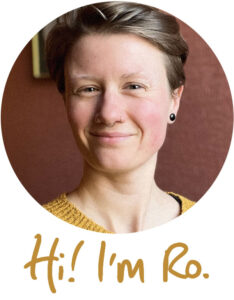Learning How To Feel More

Being unable to feel into yourself and your body cuts you off from many things. It makes pleasure difficult to really feel, with sexual pleasure often reduced to a very narrow experience that relies primarily on tension and urgency. Pleasure and sexual enjoyment happen in the body, so finding it hard to stay in your body limits the pleasure you can feel.
Becoming more aware of how your body feels from the inside not only enhances more relaxed, expanded forms of sexual pleasure, but also opens you up to noticing many other pleasurable sensations that aren’t necessarily related to sex. And the more you notice, the more there is.
Disconnection from your body also makes it hard to make the best decisions for yourself, because the alternative is to think through everything instead of understanding your needs from a deeper, more embodied, place. Thinking through things instead of feeling into them leaves you susceptible to getting caught up in stories around what you ‘should’ want, instead of trusting your instincts.
In my personal life, a couple of years ago I remember being asked the question over and over again, “What do you want?”
The truest answer I gave was, “to learn to feel more deeply.”
Despite years of meditation, I was never taught to go into my body and feel what was there, as an embodied practice.
I found it difficult to identify what really brought me pleasure, and sex was often focused entirely on the other person. I found it almost impossible to talk about what it was I really wanted.
But there’s an upside to being disconnected, too. Deep intimacy can feel really vulnerable and often scary, and avoiding staying in your body and feeling all of this can be a really helpful protection against overwhelm.
It’s possible to gently come back into connection with yourself in a way that feels safe, though. So that you can enjoy pleasure, and your body’s deep wisdom, without checking out.
Below, I’d like to share four tools that I’ve used to become more embodied and connected to myself. They are simple, everyday things that you can practice as often as you like, and they’ve been huge on my journey.
1. Practice Compassion
First of all, we must be in a place where we can accept everything we feel, or might feel, without trying to suppress it or judge ourselves for it. We must understand that learning to feel ourselves will mean allowing for the anger and grief as well as the pleasure and joy, and feeling challenging emotions or sensations can be taken as a sign that we are making progress. It’s a way of practicing intimacy with ourselves; allowing all of our experience to be seen, acknowledging it, and meeting it with kindness.
There are many ways to go about this, but my favourite is through an acknowledgment that the ‘negative’ feelings are there for a reason. We feel anger to keep us safe. Feeling grief is proof that we are capable of forming deep, emotional attachments, and it also teaches us about what’s important to us. Viewing difficult feelings in this way can help us to accept and welcome them.
2. Notice Background Pleasure
This is a simple practice that Michaela Boehm talks about often in her podcast. Throughout the day, whenever you remember, and no matter what you’re doing, feel for some pleasure. Even if you’re uncomfortable or a little too cold, or your foot’s gone to sleep, find some place in your body that feels good, and focus your attention there for a moment.
If pleasure feels inaccessible to you in that moment, focus instead on anywhere in your body that feels neutral. Where do you not feel pain or discomfort? Where feels okay?
Take a moment to savour this experience. Can you give this place your whole attention? Can you find words to describe in more detail how this place feels?
Making this a daily habit helps to keep our attention more in our whole bodies, as well as tuning us in to the pleasure and comfort we can feel.
3. Practice Embodied, Active Listening
Noticing how our bodies respond while we’re in conversation can be a really helpful way to connect with others more deeply, as well as ourselves, in a more embodied way. We’re being given so much information, all the time, by what we can feel – even if it’s numbness.
Next time you have a conversation see if you can feel any sensations while you’re listening. Is your body echoing emotions that the other person is displaying? Or are you getting a more felt sense of your own attitudes towards the person? Perhaps you’re able to pick up on what the other person is feeling before they’ve even made it explicit.
Practice noticing this experience that your whole body has in the presence of another person, without judging or attaching stories to feelings that come up.
4. Discover Your Somatic Markers
It’s called a ‘gut feeling’ for a reason. Our body can give us so much information about our needs if we pay attention, but it can take a little time to tune in to this wisdom if we’re not used to listening to it.
We can develop this sense through practice. One way I like to do this is to start with fairly inconsequential things: what kind of tea would I like to drink right now? There’s always a story attached (I never drink peppermint tea in the morning… I’m trying to drink less caffeine… last time I drank camomile tea I was too sleepy afterwards…) so it becomes a practice of gently moving my attention away from these thoughts and towards how my body feels. Does anything light up inside when I think about each option? Do I feel any closing or opening? Do these senses conflict with the stories my mind is playing through?
A helpful way to use this for me recently has involved decisions around how I spend my time; whether I really want to go out and be sociable, or whether I’m feeling obligated and actually I’d much rather stay home. Often I’ll know I’d rather take some me time when the thought of running a bath leads to a feeling of openness and relaxation in my belly.
Conversely, for me, agreeing to do something with someone who my body knows will drain too much of my energy right now is often indicated by a subtle tightness in my chest, a sensation of wanting to pull away, or a dropping sensation in my belly. I can notice these feelings in other situations too, and recognise them as a sign that I may not be doing the best thing for myself.
This is very much an ongoing journey for me, and sometimes it’s not possible or appropriate to do as my body says in this way. But developing and maintaining this sense is extremely helpful for when it is needed, and opens me up to being more present with my body and its needs.



9 Comments